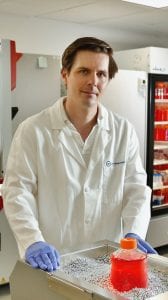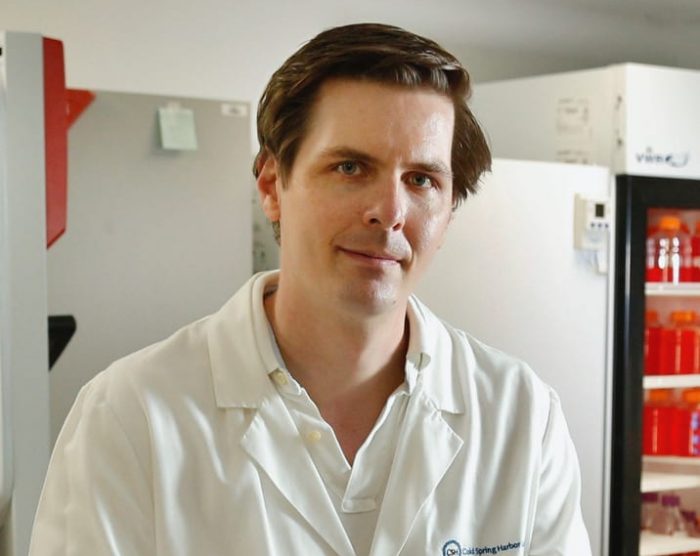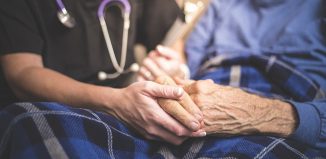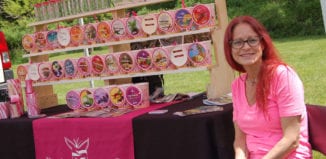Dennis Plenker leads new organoid facility at Cold Spring Harbor Laboratory
By Daniel Dunaief
If the job is too easy, Dennis Plenker isn’t interested.
He’s found the right place, as the research investigator in Cold Spring Harbor Laboratory Cancer Center Director Dave Tuveson’s lab is tackling pancreatic cancer, one of the more intractable forms of cancer.
Plenker joined Tuveson’s lab in 2017 and is the technical manager of a new organoid facility.
Organoids offer hope for a type of cancer that often carries a poor prognosis. Researchers can use them to find better and more effective treatments or to develop molecular signatures that can be used as a biomarker towards a specific treatment.
Scientists can take cells from an organoid, put them in miniature dishes and treat them with a range of drugs to see how they respond.
The drugs that work on the organoids offer potential promise for patients. When some of these treatments don’t work, doctors and researchers can continue to search for other medical solutions without running the risk of making patients ill from potentially unnecessary side effects.
“Challenges are important and there is a sweet spot to step out of my comfort zone,” Plenker explained in an email.

In an email, Tuveson described Plenker as a “pioneer” who “likes seemingly impossible challenges and we are all counting on him to make breakthroughs.”
Specifically, Tuveson would like Plenker to develop a one-week organoid test, where tissue is processed into organoids and tested in this time frame.
Organoids present a cutting edge way to take the modern approach to personalized medicine into the realm of cancer treatments designed to offer specific guidance to doctors and researchers about the likely effectiveness of remedies before patients try them.
Plenker and others in Tuveson’s lab have trained researchers from more than 50 institutions worldwide on how to produce and use organoids.
“It’s complicated compared to conventional tissue culture,” said Plenker, who indicated that considerably more experience, resource and time is involved in organoid work. “We put a lot of effort into training people.”
Tuveson explained that the current focus with organoids is on cancer, but that they may be useful for other conditions including neurological and infectious diseases.
The way organoids are created, scientists such as Plenker receive a biopsy or a surgical specimen. These researchers digest the cells with enzymes into singular cells or clumps of single cells and are embedded. Once inside the matrix, they form organoids.
When they “have enough cells, we can break these down and put them into multi-well plates,” Plenker explained. In these plates, the scientists test different concentrations and types of drugs for the same patient.
It’s a version of trial and error, deploying a range of potential medical solutions against cells to see what weakens or kills cells.
“If you do that exercise 100 times, you can see how many times compound A scores vs. C, E and F. You get a sense of what the options are versus what is not working,” Plenker said.
While scientists like Plenker and Tuveson use targeted drugs to weaken, cripple or kill cancer, they recognize that cancer cells themselves represent something of a molecular moving target.
“There is a very dynamic shift that can happen between these subtypes” of cancer, Plenker said. “That can happen during treatment. If you start with what’s considered a good prognosis, you can end up with a higher fraction of basal cancer cells” which are more problematic and have a worse prognosis. “We and others have shown that you have a mixture of cell types in your tumor all the time.”
Part of what Plenker hopes to discover as the director of the organoid center is the best combination of ingredients to foster the growth of these versatile and useful out-of-body cancer models.
The gel that helps the cells grow is something Plenker can buy that is an extracellular matrix rich matter that is of murine, or rodent, origin. He hopes to develop a better understanding of some of these proprietary products so he can modify protocols to boost the efficiency of the experiments.
Plenker is “trying to innovate the organoids, and so he may need to adjust conditions and that would include inventing his own recipes,” Tuveson explained.
The facility, which received support from the Lustgarten Foundation, will engage in future clinical trials.
The type of treatments for pancreatic cancer patients typically fall into two arenas. In the first, a patient who is doing well would get an aggressive dose of chemotherapy. In the second, a patient who is already sick would get a milder dose. Determining which regimen is based on the current diagnostic techniques.
Plenker and his wife Juliane Dassler-Plenker, who works as a post-doctoral fellow in the lab of Mikala Egeblad at Cold Spring Harbor Laboratory, live in Huntington. The pair met in Germany and moved to the United States together.
Plenker calls himself a “foodie” and appreciates the hard work that goes into creating specific dishes.
In his career, Plenker always “wanted to help people.” He has appreciated the latest technology and has disassembled and put back together devices to understand how they work.
Prior to the pandemic, Plenker had gone on short trips to Germany to visit with friends and relatives. He is grateful for that time, especially now that he is much more limited in where he can go. He appreciates his landlord and a second American family which helps the couple feel welcomed and grateful.
In 2017, Plenker recalls attending a talk Tuveson gave in Washington, D.C. in which he invited anyone in the audience who wanted to improve a test to come and talk to him after the presentation.
“I was the only one in that regard who talked to him” after that lecture, Plenker said.







